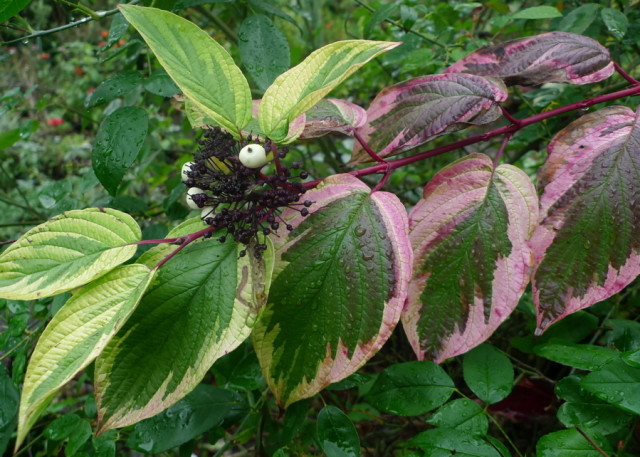Five Reasons to Love Twiggy Dogwoods

Cornus sericea 'Hedgerows Gold'. Variegated gold and green foliage (left) and the beginning of rosy red fall color (right).
Image: Kate Bryant
Variegated red-twigged dogwood (Cornus sericea ‘Hedgerows Gold’) is beautiful and versatile in the garden. Here are five compelling reasons to grow it.
First off, some background. Hedgerows Gold is a cultivated variety of our native red-twigged dogwood, found and selected by David Mason and Susie Grimm of Hedgerows Nursery of McMinnville. Although this delightful small nursery closed its doors a few years ago, Hedgerows Gold dogwood is a tribute to a superb nursery and the owners’ contributions to horticulture in the Pacific Northwest.
Why is it so fantastic for nearly any garden?
It’s stunning in every season of the year.
In spring, vertical golden buds appear on vibrant crimson stems. In summer, creamy white and green variegated foliage and flat white heads of flowers. In autumn, the variegated leaves take on a rosy pinkish-red cast before turning fire-engine red and dropping. The white fruit really start to show up in fall, too, on red stems that soon turn black. Winter, perhaps the most elegant of all: truly vibrant red stems that shine against the brown and gray of a Pacific Northwest winter garden.
It’s great for wildlife –and it’s native, to boot.
There are several species of “twiggy dogwoods” and all are beloved for their glowing red, yellow or orange winter twigs. All – native or not – produce late spring to summer flowers that supply butterflies and bees with abundant nectar and pollen. The ripe fruit is also beloved to birds. Furthermore, many people believe that it’s best to grow true regional native plants, which often develop subtle symbiotic relationships with native insects, birds and other wildlife.
It’s easy to grow!
White Cornus sericea grows naturally in damp or wet soils (in ditches and alongside ponds and wetlands), it’s surprisingly tolerant of dry conditions. Heavy, wet clay soils are great, but so is rich, amended garden soil, too. It thrives in sun or shade, although the stems and leaves color up best in sun, and it produces more flowers (and therefore fruit) in sun.
The PNW native species is Cornus sericea (syn. C. stolonifera) but there are others including C. alba (Siberian dogwood) and C. sanguinea (European dogwood) which also have colorful winter stems and beautiful foliage (green, gold or variegated) and all produce butterflies beloved to butterflies and bees and fruit that is enjoyed by birds in winter.
It’s easy to propagate and is an economical way to cover a lot of ground.
Most shrubby dogwoods can be propagated easily. Buy one large plant and you’ll have enough cutting material to start several new plants this winter. I usually take cuttings throughout the winter and just poke them into pots of well-drained potting soil and leave them outside over the winter. They root with nary a thought from me. I am pretty casual: I just snip 4-6” lengths just a quarter to half inch below a leaf node and poke them in to the potting soil, a couple of inches deep. They root during the winter, and usually have developed enough roots to transplant by April. Easy!
Shrubby dogwood can be shaped or pruned into various forms to fit the garden.
Hedgerows Gold reaches around 12’ tall if left to its own devices. But you can engineer the height to suit your needs, too. To maintain as a 4-6-foot tall shrub, just take about a quarter (25%) of the oldest stems down to a couple of inches in height in March. This helps maintain the height and keep fresh, colorful stems growing from the base. You can also chop them all down to about 4-6” in height, although it’s best to wait until your plant is a few years old before attempting such a drastic measure. You can also limit water (and, naturally, fertilizer) to keep plants growing more slowly. If you’d like a small tree instead of a multi-stemmed shrub, select and train a single trunk and remove all competing sprouts. You might want to stake the selected trunk-to-be. It takes a few years, but eventually, the main trunk will grow large and sturdy, and the bark will turn brown, with plenty of bright, fresh red branch tips to admire in winter.
Try some other selections, which vary in size, leaf attributes and twig color: Cornus sericea ‘Kelseyi’ is a 1.5 foot tall cultivar, which spreads to produce a low-growing thicket of red-tipped, yellowish-green stems. Cornus sanguinea ‘Midwinter Fire’ has brilliant reddish-orange stems on a plant reaching 8-12’ tall and wide, with yellow fall color. Cornus alba ‘Aurea’ has lovely golden foliage and red stems on an 8-10’ tall plant. (Its yellow leaves can burn in full sun unless provided with good summer water.) Fall color is orange and red. Cornus alba ‘Sibirica’ reaches about 10’ tall, with vibrant red stems and reddish fall color.
